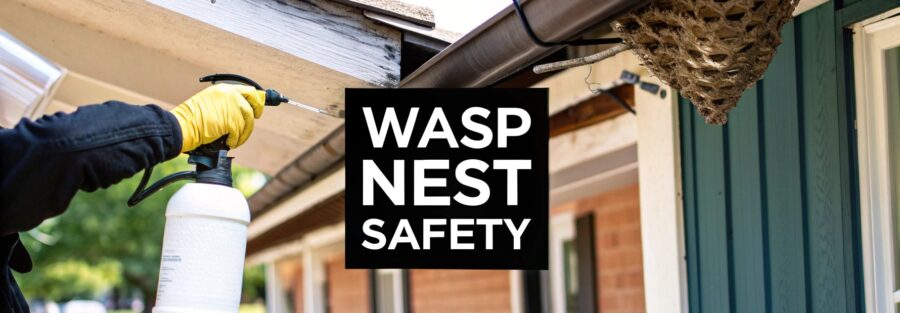It's an unsettling moment for any homeowner: you're out in the garden and spot it. That papery, grey structure tucked under the eaves or in a corner of the shed. A wasp nest. Your first instinct might be to panic, but what you do next is crucial for keeping everyone safe. The key is to take a deep breath and follow a calm, methodical approach to figure out the risk before deciding how to deal with the nest.
Your First Steps After Finding a Wasp Nest

Forget panic; a strategic response is far more effective. The moment you spot what looks like a nest, your goal is to gather information from a safe distance without disturbing the insects. Your absolute priority is the safety of anyone on your property.
Secure the Area Immediately
First things first, create a safe zone. Wasps are fiercely territorial and will aggressively defend their home if they sense a threat. This can be triggered by vibrations, loud noises, or simply you getting too close for their comfort.
- Keep Children and Pets Indoors: Their natural curiosity can easily lead them into the danger zone, putting them at a significant risk of being stung.
- Inform Family Members: Make sure everyone in the house knows exactly where the nest is and understands the need to stay well clear of that area.
- Pause Garden Activities: Hold off on mowing the lawn, trimming hedges, or any other jobs that create noise and vibrations near the nest until it's been dealt with.
Think of this temporary exclusion zone as your first line of defence against accidental stings.
Why You Must Not Provoke the Nest
It's tempting to want to take immediate action. I've heard it all – from spraying it with a garden hose to trying to knock it down with a broom. These are incredibly dangerous ideas and are almost guaranteed to trigger an aggressive, swarming response from the entire colony. Remember, a single wasp can sting you multiple times, and an agitated nest can release hundreds of angry defenders.
Crucial Safety Tip: Never, ever block the entrance to a wasp nest. If you trap them, they will find another way out. This could mean chewing through plasterboard and ending up right inside your home.
This year, being cautious is more important than ever. We've seen a huge spike in wasp activity across the UK in 2025. Some pest control services have reported over a 600% increase in wasp-related callouts compared to last year. This boom is thanks to an unusually warm and wet spring, which created the perfect breeding conditions for wasp populations to explode. You can discover more insights about this insect explosion trend and what it means for homeowners.
Once the area is secure, your next move is to assess the situation from afar. What are you looking at? Is it a small, golf-ball-sized nest just starting under a windowsill, or is it a huge, bustling nest high up in a tree? This quick evaluation will tell you whether a cautious DIY approach is even an option or if it's time to call in the professionals.
Initial Wasp Nest Risk Assessment
When you find a nest, a quick assessment can help you decide on the next steps. Use this table as a rough guide to gauge the immediate risk.
| Nest Location | Typical Risk Level | Recommended Immediate Action |
|---|---|---|
| Loft, Shed, or Outbuilding | Low to Medium | Secure the area. Monitor from a distance. A professional is usually required. |
| In a Bush or Hedge | Medium to High | Keep a wide berth. Avoid garden work nearby. Call a professional. |
| Near a Door or Window | High | Use an alternative entrance. Seal any gaps. Call a professional immediately. |
| Underground (in the lawn) | High | Mark the area and avoid it completely. Mowing is extremely dangerous. Call a professional. |
| In Wall Cavities | Very High | Do not block the entrance. Listen for buzzing indoors. Call a professional immediately. |
This table provides a starting point for your decision-making. High-traffic areas or large, active nests almost always require professional intervention.
Identifying Common UK Wasp Species and Nests

Before you can even think about tackling a wasp nest, you need to know exactly what you’re up against. Not all buzzing insects are created equal, and figuring out the species and where they’ve built their home is the critical first step to dealing with them safely. This knowledge is key to understanding their likely behaviour and aggression levels.
Most of the time, the nests you’ll come across will belong to either the Common Wasp (Vespula vulgaris) or its very close cousin, the German Wasp (Vespula germanica). These are the classic yellow-and-black striped pests that have a knack for ruining a good picnic. They're highly social insects, and by late summer, a mature nest can be home to over 5,000 individuals, making them a serious threat if you get too close.
The Most Common Culprits
While they look similar from a distance, the main species you'll encounter have a few tell-tale differences. It's also worth knowing how to spot a hornet, which is much larger and more intimidating, though thankfully less common.
Here’s a quick guide to help you identify them from a safe distance:
- Common Wasp (Vespula vulgaris): Look for a distinct anchor-shaped black mark on its face. Their nests are typically a pale grey or beige, with a papery texture made from chewed wood pulp.
- German Wasp (Vespula germanica): This one has three small black dots on its face instead of an anchor. The nest looks similar but often has a more shell-like, greyish appearance.
- European Hornet (Vespa crabro): These are noticeably bigger than common wasps, with a reddish-brown and yellow body. Their nests are also made from wood pulp but are usually brown and hidden away in dark, sheltered spots like hollow trees or loft spaces. While their sting packs more of a punch, they are generally less aggressive unless you directly threaten their nest.
Where to Look for Nests
Wasps are masters of opportunity. They’ll set up a home in just about any sheltered spot that keeps them dry and protected from the elements. Knowing their favourite hiding places can help you find a nest before it spirals out of control.
One of the biggest giveaways is a constant, steady stream of wasps flying to and from a single point. You might not see the nest itself, but this flight path is a dead giveaway that one is nearby.
Expert Tip: If you see wasps vanishing into a small hole in a wall, an air brick, or under a roof tile, the nest is almost certainly inside the structure. Whatever you do, do not block the entrance. Trapped wasps will chew their way out, and that could mean they end up inside your house.
Keep an eye out for nests in these common locations:
- Lofts and Attics: Dark, quiet, and perfect for a growing colony.
- Sheds and Garages: Often found tucked away in corners or under roofing panels.
- Wall Cavities: A very common and tricky place to deal with a nest.
- Under Eaves: Protected from the rain and easy to miss.
- Underground: They love taking over old animal burrows or setting up in holes in the lawn.
Once you’ve identified the insect and pinpointed the nest's location, you're in a much stronger position to assess the risk. A small, visible nest in the corner of a shed is one thing; a huge, hidden colony inside your walls is a completely different ball game.
Safe DIY Wasp Removal for Small Nests

For the brave and well-prepared, tackling a tiny wasp nest might seem like a manageable weekend job. But let me be clear: this isn't a decision to take lightly. A DIY approach is only ever suitable under a very strict set of conditions where the risk is as low as it can possibly be.
If you're even considering this route, the nest must be no larger than a golf ball. This size usually means it’s an early-season nest with just the queen and a handful of her first workers. It also absolutely has to be easily accessible at ground level and located well away from high-traffic areas like doorways, paths, or anywhere the kids play.
Preparing for a Safe Takedown
Timing and protection are everything when you decide to handle a wasp nest yourself. Get either of these wrong, and you could be facing a very painful, dangerous situation. Wasps are at their least active—and most likely to be inside the nest—during the cooler hours of dusk and dawn. These are the only safe times to even think about approaching.
Your personal protective equipment (PPE) is non-negotiable. You cannot have any exposed skin. This means wearing:
- Thick, full-body clothing, like overalls or multiple layers.
- Sturdy gloves that a desperate wasp can't easily sting through.
- A full-face veil or hood to protect your head, face, and neck.
- Goggles to shield your eyes from both angry wasps and chemical spray.
And please, remember that a bin bag and a pair of marigolds will not cut it. Wasps can and will sting straight through thin materials.
Crucial Safety Warning: If you feel even slightly unsure at any point, or if the nest is bigger than you first thought, stop immediately. It is always, always better to back away and call a professional than to risk a swarm attack.
Choosing and Using the Right Product
When you go to a DIY shop, you'll find consumer-grade wasp nest destroyer products, usually foams or powders. It's vital you understand how to use them properly. Foams are generally excellent for exposed nests because they expand to smother the entrance, trapping the wasps inside while the insecticide gets to work.
Always read and follow the manufacturer’s instructions to the letter. Most sprays are designed to be used from a safe distance of at least a few metres. Stand well back, aim carefully at the nest opening, and spray generously until the entrance and the nest itself are saturated. Once you've applied the treatment, leave the area immediately. Do not hang around to see what happens.
Here in the UK, professional wasp nest removal involves a proper assessment of the species and nest location to choose the right tool for the job. Experts use specific insecticides for different situations—dust for tight spots, foam for wall cavities, and sprays for exposed nests, all while wearing thick, fully sealed protective suits.
If you're facing anything more complicated than a tiny, accessible nest, it’s best to leave it to those with the right gear and knowledge. For more complex cases, exploring professional wasp nest removal options is always the safest and most effective choice.
When You Must Call a Professional
It's tempting to think a quick spray from the local hardware shop will solve your wasp problem, but knowing when to step back is the most important part of the job. Trying to tackle a nest that’s beyond your capabilities isn't just risky—it can be downright dangerous for you, your family, and even your neighbours.
There are a few red flags that should immediately tell you it's time to put the DIY kit down and pick up the phone.
First, size matters. If the nest is any bigger than a tennis ball, that’s your cue. A nest of that size is well past the early stages. It’s a mature, thriving colony, likely home to thousands of wasps that will aggressively defend their territory. Standard DIY treatments just don't have the power to deal with those numbers, and any attempt is almost guaranteed to provoke a mass attack.
Hard-to-Reach and Hidden Nests
The nest's location is just as crucial as its size. If it's tucked away at height—think under the eaves of a two-storey house or high up in a tree—the risks multiply instantly. Balancing on a ladder while trying to spray a treatment and fend off angry wasps is a recipe for a serious accident.
Nests hidden inside the structure of your home are another kettle of fish entirely.
- In Wall Cavities: Wasps are experts at finding tiny gaps or air bricks to get into wall voids. If you try to treat these yourself, you could end up with wasps chewing their way into your living room to escape the poison.
- In Loft Spaces: A dark, cluttered loft is the last place you want to be when confronting an agitated colony. With poor footing and no easy escape route, you’re cornered.
- In Chimney Stacks: Nests in chimneys are notoriously tricky. They require specialist equipment to remove safely without blocking the flue or sending wasps down into your fireplace.
In short, if you can't see it and reach it easily from the ground, it's a job for the experts.

As you can see, factors like size, location, and height are pretty clear signs that a professional is your only safe bet.
Allergies and Guarantees
The most important factor of all is health. If anyone in your house—or even a next-door neighbour—has a known allergy to insect stings, do not attempt any DIY removal. It’s simply not worth the risk of triggering anaphylactic shock. A professional service completely removes that danger.
Hiring a pro gives you more than just a powerful insecticide. You get a guaranteed solution, expert knowledge, and most importantly, peace of mind. A qualified technician will carry out a full risk assessment, explain exactly how they’ll treat the nest, and tell you what to expect afterwards.
When you weigh the options, the choice often becomes clear.
DIY vs Professional Wasp Nest Removal
Deciding whether to tackle a wasp nest yourself or call in the professionals can be tricky. This table breaks down the key factors to help you make a safe and informed decision.
| Factor | DIY Approach | Professional Service |
|---|---|---|
| Nest Size & Age | Only suitable for very small, new nests (golf ball size or smaller). | Can safely handle any size nest, from a new build to a huge, mature colony. |
| Location & Access | Limited to easily accessible nests at ground level. | Equipped for nests at height, in lofts, wall cavities, or underground. |
| Safety Risks | High risk of multiple stings, allergic reactions, and falls from ladders. | Minimal risk to you and your family. Technicians wear full protective gear. |
| Effectiveness | Often fails to kill the entire colony, leading to re-infestation. | Guaranteed eradication. Uses professional-grade insecticides that are not available to the public. |
| Cost | Cheaper upfront (£10-£20 for a spray), but can be costly if it fails. | Higher initial cost, but provides a definitive, one-time solution. |
| Time & Effort | Requires you to research, buy products, and carry out the treatment at dusk. | A quick phone call is all it takes. The job is usually done within an hour. |
Ultimately, while a DIY approach might seem like a cost-saver for the smallest, most accessible nests, the safety, effectiveness, and peace of mind that come with a professional service are invaluable in almost every other scenario.
If you're dealing with a tricky situation, exploring professional pest control services is always the smartest and safest move.
How to Prevent Wasps from Building Nests
The old saying “prevention is better than cure” is never more true than when dealing with wasps. The best way to handle a wasp nest is to make sure one never gets built in the first place.
This is all about being proactive. You need to make your property as unappealing as possible to the queen wasps that pop up in spring, all looking for the perfect spot to start their new colony. It's a game of small, consistent actions that, when added together, create a powerful deterrent.
It all starts with a thorough look around the outside of your property. Put yourself in the mind of a queen wasp: where would you go for shelter and security? Your job is to find and seal off every potential entry point, no matter how small. A bit of sealant now can save you a world of trouble later on.
Fortifying Your Home's Defences
Making your home physically difficult to get into is the absolute cornerstone of wasp prevention. You’d be surprised how easily a queen can wiggle through tiny structural flaws to set up a hidden nest inside your walls or loft, where it's a real headache to deal with.
Start by having a close look at these areas:
- Cracks and Gaps: Check around window and door frames, and where utility pipes enter the house. Use a good quality exterior caulk to seal these openings up tight.
- Vents and Air Bricks: Soffit vents, air bricks, and dryer vents are basically open invitations. Cover them with a fine insect mesh to block access without stopping the airflow.
- Roofing and Eaves: Keep an eye out for any loose or damaged roof tiles, fascia boards, or soffits. Fixing these not only keeps wasps out but also protects your home from damp.
A Proactive Mindset: Regular maintenance is your best defence. A quick walk around your property every spring to check for potential nesting spots can stop a full-blown infestation from taking hold by summer.
By systematically sealing these weak points, you make it dramatically harder for a queen to establish her colony inside your home.
Making Your Garden Less Attractive
Your garden can either be a five-star resort for wasps or a place they'd much rather avoid. The choice really comes down to how you manage the food and water sources they find irresistible, especially in late summer when their diet shifts from protein to sugar.
Pay close attention to garden hygiene. Make sure you clear up fallen fruit from trees promptly, as fermenting apples and plums are a huge draw for them. Ensure your rubbish and compost bins have tight-fitting lids and are kept clean to cut down on odours. If you have pets, don't leave their food bowls sitting outside for long periods.
While some people swear by those decoy "wasp nests" you can buy, their effectiveness can be pretty hit-or-miss. A much more reliable strategy is just simple, consistent vigilance. Regularly check common outdoor nesting spots like sheds, garages, playhouses, and under the decking. Catching a nest when it’s only the size of a golf ball makes it a far simpler problem to solve.
If you find one that's already well-established, understanding your options for professional wasp and bee treatment can provide a safe and effective solution without putting yourself at risk.
Still Got Questions About Wasp Nests?
Even with a plan in hand, it's completely normal to have a few lingering questions. When you're dealing with something as nerve-wracking as a wasp nest, getting clear answers is the best way to feel confident and safe. Here are some of the most common queries we get from homeowners.
What Happens if I Just Leave a Wasp Nest Alone?
It’s a tempting thought, isn't it? Especially if the nest seems tucked away where it’s not bothering anyone. And to be fair, if a nest is genuinely in a remote spot—far from people or pets—leaving it alone is sometimes a perfectly fine option. Nature will eventually run its course.
However, if that nest is anywhere in or near your home, shed, or garden, ignoring it is a gamble. That colony will keep expanding all summer long, potentially hitting 5,000 to 10,000 wasps by its peak. As the season winds down, their life cycle changes, and they can become much more aggressive, which dramatically ups the risk of stings.
The colony will die off naturally with the first hard frost, but the empty nest can cause other problems. While wasps never re-use the exact same nest, a new queen might see that sheltered spot as the perfect real estate for building a brand new one next spring.
How Can I Tell the Difference Between Bees and Wasps?
This is probably the most important question to get right. Bees are vital pollinators, and many species are protected. Their nests need to be handled with care, usually by a professional beekeeper, not a pest controller. Wasps, on the other hand, are treated as pests when they nest too close for comfort.
Here’s a quick guide to help you spot the difference:
- Wasps: Look for that classic, defined "waist" between their body segments. They have smooth, almost shiny bodies with bold, bright yellow and black stripes. Think sharp and sleek.
- Honeybees: These are generally furrier and rounder than wasps. Their colouring is a bit duller, more of a muted orange or brown and yellow banding.
- Bumblebees: You can't miss these. They're big, very furry, and almost spherical. They have a loud, distinctive buzz as they fly.
Key Takeaway: A smooth, slender body with bright, stark markings almost always means you're dealing with wasps. A fuzzy, robust body points towards a bee species.
How Much Does Professional Wasp Nest Removal Cost in the UK?
The cost for a professional to come out can vary a bit, mostly depending on your location and how tricky the nest is to get to. For a standard, straightforward job, you can usually expect to pay somewhere between £50 and £100.
Now, if the nest is way up high, buried inside a wall cavity, or needs special gear like scaffolding to reach, the price will naturally go up. Any reputable pest control company should give you a fixed quote right over the phone after asking a few simple questions about where the nest is and how big it is.
Most professionals also guarantee their work. That means if the first treatment doesn't quite get the job done, they'll come back and do it again for free. That guarantee is a big part of what makes professional help such good value when you're figuring out how to deal with a wasp nest for good.
At Pest Predators Limited, we provide expert, evidence-based solutions to safely and effectively handle your wasp problems. Our qualified Field Biologist ensures every treatment is not only successful but also environmentally responsible. For guaranteed peace of mind, get in touch with us today.



